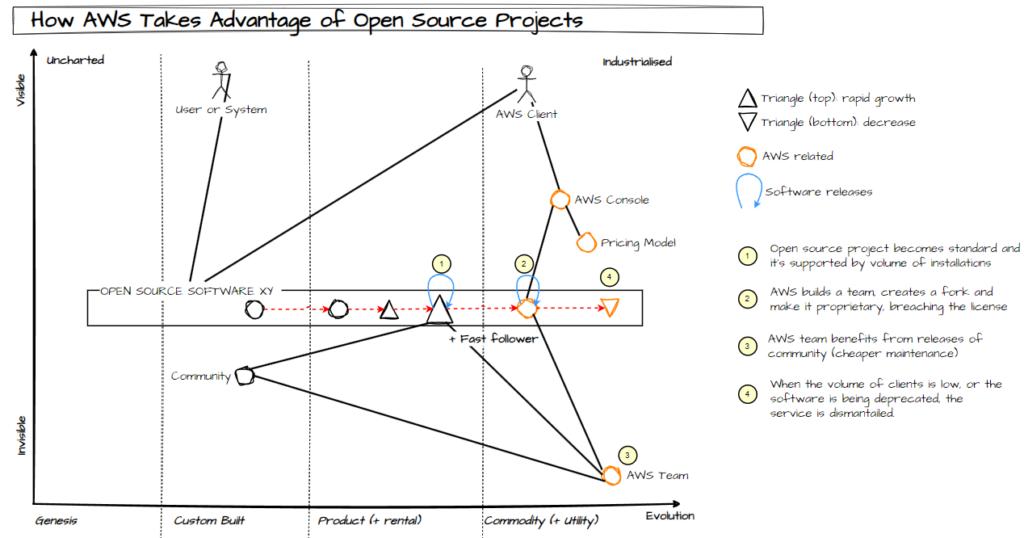This gameplay has not a name in the table of Wardley’s gameplays, but it’s something that is happening in an ongoing basis.
The map

The steps
Typically Open Source projects start as response to a specific technical problem, and if that problem to be solved is common, both: community and product grows.
Some of these projects, not too much, expand in a way that becomes standard for a specific problem or scenario. For these few products, the community and the core teams behind the scene are very happy and proud of the journey.
Step 1. Open source project becomes standard and it’s supported by volume of installations.
An Open Source project that gains traction of the market is the result of many variables. Majority of the projects are not able to gain traction in the extended community.
This is something that takes years, and there’s not only external challenges, there are also internal challenges of governance and stable maturity of the project.
In any case, there are projects that are able to do it, and those that play the game in the area of work of AWS are subjected to this situation.
Step 2, AWS decides to build the capability
AWS analyze the impact of this Open Source product by different perspectives:
- Size of the community.
- Expansion of the product.
- Type of Open Source License.
- Level of use by AWS users.
- Etc
Once the project is selected, they build a focal team of experts in the product, world class people, and are combined with some experienced people from AWS.
These people create a fork and adapt to turn it into a AWS service that can be consume through the AWS console.
Implicitly, they make it proprietary, breaching the standard licenses that the work done over a Open Source product, should be also public so the community can benefit from the advances done by others (that are community too).
Disclaimer: I know, there are many Open Source type of licenses, and not all of them are subjected to make it available to others.
Step 3, AWS team benefits from releases of community
Here it’s important to remark too, that during this process the AWS team can benefit from releases of community (cheaper maintenance). What is also true is that the speed of evolution that the community can do could be faster than the work done by a restricted/individual team.
Usually, from the commercial point of view, AWS will do the go to marketing campaign to position their new service into the different layers of their commercial ecosystem. This, in addition to the clients and partners aware of the product life cycles, use to make the traction of use to grow at good speed.
This provides AWS a new thread of revenue which intellectual property is aligned with the needs of a proven demand and in alignment with the license, but all this destroys part of the original purpose of the community that in some cases are broken or they adopt other direction.
The type of clients AWS attends are different in some way to the first clients that uses these products (as indicated in the map).
Not all projects succeed. Here AWS has a failure rate too, not all the open source projects that are closed by AWS are successful projects. There are many factors here: target client, market fit, execution of the project, etc.
Step 4, AWS decommission the service
When the volume of clients is low, or the software is being deprecated, the service is dismantailed with enough time for the clients to move to other service (usually available in AWS too).
AWS Open Source Community
This is an old program where they are trying to contribute to build a community where open source projects born, grow or mature.
Examples
- Cloudwatch Synthetic Recorder: https://www.theregister.com/2020/10/16/aws_headless_recorder/
- MongoDB: https://www.computerweekly.com/news/252455700/AWS-pushes-Mongo-DB-compatible-alternative-as-licences-change
- Elastic: https://www.computerweekly.com/news/252475618/AWS-hits-back-at-open-source-theft-allegations
- Redis : https://logz.io/blog/redis-no-longer-open-source-is-valkey-successor/
The list is very extended,
Takeaways
In a competitive market where there is a good flow of demand and supply, the climatic pattern “there is no choice over evolution” applies, which means the competition changes, evolves to a different ways. In this case the Open Source world is in constant evolution and the constraints and challenges are different.
AWS can be seen as a threat but it also can contribute to the popularity of an Open Source project, expanding their base of clients (their client base is not 100% the same one).
When you create an open source project the selection of the type of license tells you a lot about what can be happening if you succeed.
In some way what AWS is doing is similar to the ILC gameplay they do in Amazon.